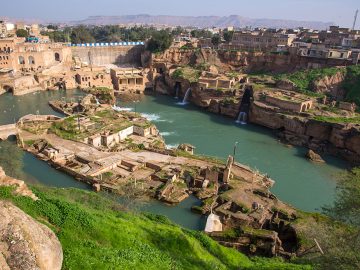
Located in the north of Khuzestan province, Shushtar has hosted the River of Karun for millennia and historical hydraulic system on it for centuries. The hydraulic system has included a series of bridges, canals and tunnels, weirs, water cascades and watermills tracking back to 5th centuries before the Christ and the era of Darius I of Persia. This engineering masterpiece has been considered as a world wonder by many travelers.
When the Romance Valerian I was defeated by Sassanid king, Roman soldiers were captured and delegated to constructing a bridge that is known as Shadorvan Bridge or Caesar Weir. This construction is the first combination of bridge and weir in Iran that diverted the water into different canals. Mizan is another weir credited to the Sassanid Shapur I (215 – 270 CE) involves two main diversion canals on the river of Karun namely Shotayt and Gargar which the latter is still used for irrigation.
Water cascades and watermills originate in the Sassanid era. These water cascades push and spin the water mill wheels through numerous canals that eventually fall into basins. The Salasel Castle was the operating center of the hydraulic system along which it served as a defensive structure comprising numerous yards and rooms. However, from this Achaemenid structure, some underground rooms and Daryun canal, an artificial canal to control and share the water, are only extant today.
Mahi Bazan Weir, Khak Weir, Lashkar Bridge-weir, Sharabdar Weir, and an ancient handmade stairway are among other constructions of the complex. Followers of Mandaeism, a Gnostic religion with an emphasis on John the Baptist, has their own constructions in this complex as they practice some of their rituals with running water.
Shushtar historical hydraulic system affirms human ingenuity in the 3rd century CE and is evidence to the diversity of engineering technics from Elamite, Mesopotamian, and Roman civilizations. It also presents technical development in controlling water in human societies in harmony with their semi-desert nature.
This work was globally registered in 2009.


